Well, I suppose it was only a matter of time before someone asked for this, given the “accuracy” of Shekhar Kapur’s Elizabeth. In fact, I was asked the very same day I published Everything wrong with Elizabeth, so if anything I’m just sorry it took so long to write.
While Elizabeth took historical revisionism and somehow still managed to make a well-received film with a Rotten Tomatoes score of 81% Elizabeth: The Golden Age took the same approach but with the far less impressive score of 35%. Apparently, despite the lavish costumes and impressive sets, it lacked the depth of the original. I didn’t see any depth in the original, to be honest, and am in the minority in thinking that the original was worse. Not that that’s much of a compliment; I find Elizabeth: The Golden Age to be only slightly less unbearable than Elizabeth. Though given the choice, I wouldn’t watch either.
Elizabeth: The Golden Age takes place almost thirty years after Elizabeth, charting the execution of Mary, Queen of Scots and the Spanish Armada, focusing on Elizabeth’s relationship with Sir Walter Raleigh all the while somehow managing to be even less historically accurate than the first film.
Mary, Queen of Scots
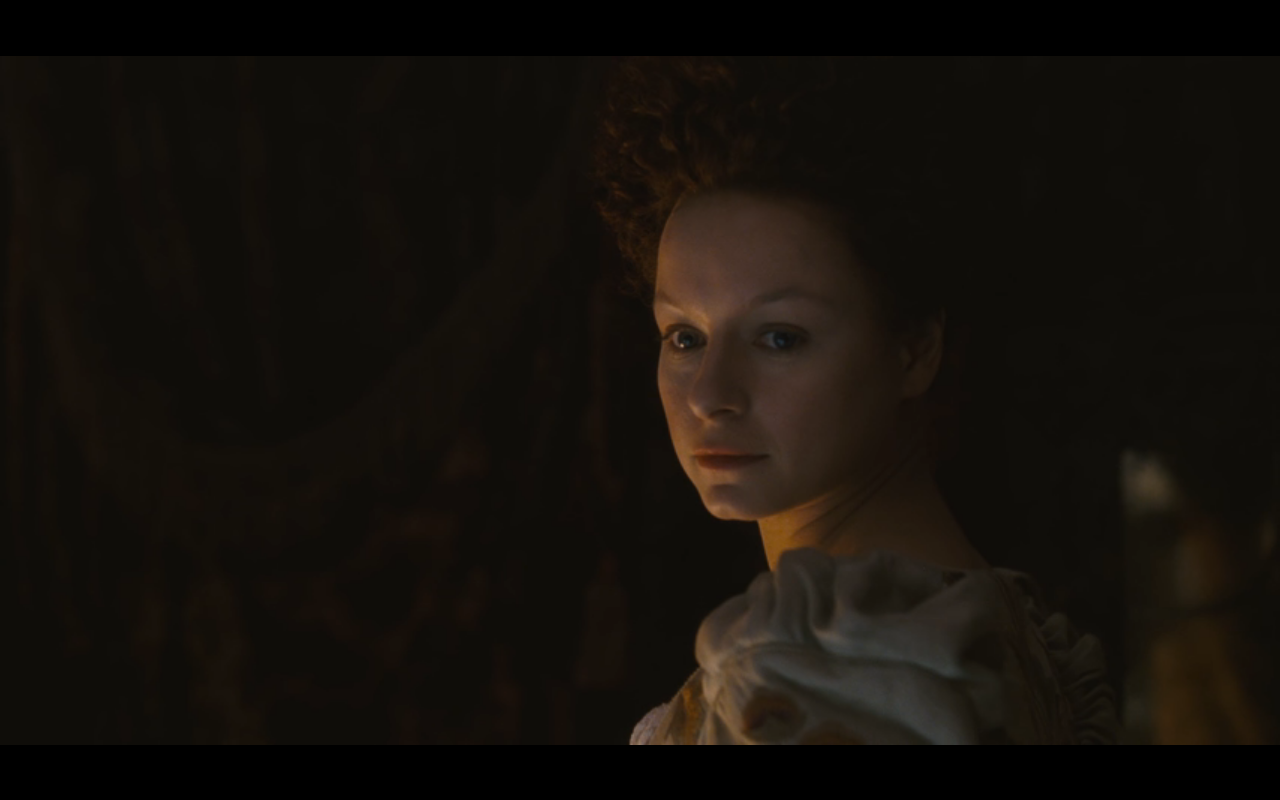
The Film: The very Scottish, Mary, Queen of Scots lives at Fotheringay under the supervision of Sir Amyas Paulet (imprisoned would be a bit of a stretch). There she keeps her own court, plotting against Elizabeth with her ladies, who refer to the Queen as ‘the bastard usurper’ and discuss treason in the strongest terms. There is little security – her ladies are allowed to come and go as they please and as a result she is able to conspire with Walsingham’s full knowledge. When Sir Amyas confronts her about smuggling letters she openly admits to doing so, claiming that they are her private correspondence that he has no right to read. She ends the conversation by openly mocking and insulting the Queen until Sir Amyas leaves in disgust.
Conspiring with Jesuits, Mary gives the order for them to move against Elizabeth. When the plot fails, Sir Amyas confronts her again showing the evidence against her; Mary is unable to contain her distress screaming that she has been betrayed. Despite this, she meets her death gracefully, while by contrast, Elizabeth paces hysterically. Mary is executed and Elizabeth collapses into Raleigh’s arms to be comforted by him and Bess.
In History: Firstly, Mary did not speak with a Scottish accent. Although her father had been the Scottish king, Mary spent most of her upbringing in France, her mother’s home country and so her accent was French rather than Scottish. Mary was imprisoned in various castles across England and due to the frequent plots involving her (whether she was implicated or not), she was moved into more and more stringent care. Around the time the film is set Mary had been placed in the care of Sir Amyas Paulet, the most unsympathetic of her custodians, though this was at Tutbury Castle and later, Chartley Hall. She would have had a minimal household around her, as Elizabeth kept her on a tight rein and they would not have had the freedom to plot the way they do, they certainly would not have felt free enough to openly refer to slitting Elizabeth’s throat.
Mary responded to letters regarding the Babington Plot, unaware that the scheme is being watched by Walsingham. With proof of her guilt in writing. Elizabeth’s councillors brought pressure on the queen to have Mary tried for treason. During the trial Mary conducted herself as a queen, denying the authority of the court to try her in the first place. The execution was less graceful, though Mary again conducted herself with dignity, but the executioner took two strokes and when he held her head up to the assembled crowd her hair, revealed to be a wig, came away and her head thudded to the ground.
The Babington Plot

The Film: The Babington Plot is headed by Robert Reston, Thomas Babington, William Walsingham, the Spanish king and Mary, Queen of Scots. Walsingham is aware of the plot, allowing it to continue so that he can use the evidence gathered against its conspirators.
The plot culminates with an assassination attempt on Elizabeth, Babington levels a hand pistol at her, calls her a whore, declares for Mary of Scotland, but fails to follow through when he pulls the trigger to find the gun isn’t loaded. As a result, Babington is apprehended, his accomplices captured and Mary, Queen of Scots is put on trial. Walsingham asks Reston why the gun was not loaded but receives no answer. After her execution, Walsingham reveals to his horror that he has been duped by Spain; the plot was never meant to kill Elizabeth and simply ensured the Queen would act against Mary giving Spain a pretext to invade England.
In History: The main conspirators of the Babington plot were an English noble, Anthony Babington and a Jesuit priest, John Ballard with the potential support of France and Spain. The intent was for Spain to invade England to place Mary, Queen of Scots on the throne, while men already in England would assassinate the Queen clearing the way for Mary’s succession. John Ballard appears as a conspirator in Elizabeth and has already been killed so is replaced with the character of Robert Reston in The Golden Age. Walsingham was indeed aware of the plot and allowed it to continue so that he might gather evidence against Mary, Queen of Scots, but once that evidence was acquired the plot was shut down and the conspirators were arrested. It was not allowed to continue to the point where Elizabeth was in any kind of danger, and Babington certainly didn’t get close enough to the Queen to level a gun against her.
Although there was an element of the plot that would have asked the Spanish king to invade on Mary’s behalf, the entire plot was not orchestrated by Philip of Spain who needed less of a pretext to invade than the film suggests.
Philip of Spain
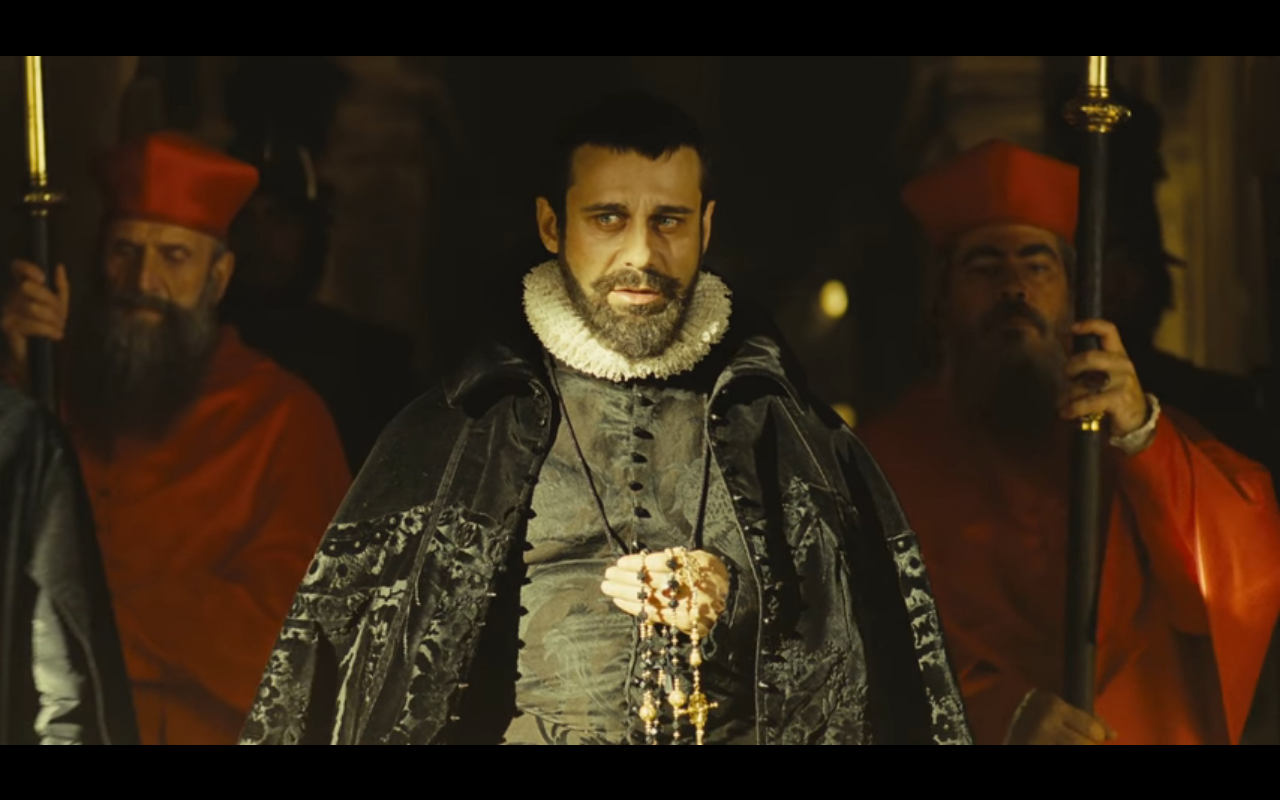
The Film: Philip of Spain, king of the most powerful nation in the world, is waging a holy war against Europe, subjugating it to the Catholic faith with England being the only country to stand against him. Philip is entirely motivated by his faith and his devotion borders on mental instability. Philip tells his daughter Isabella that they must remove Elizabeth setting England free from the devil. The child Isabella remains mute throughout the film, so it is unknown whether she approves or disproves of his actions, though she faithfully carries a doll of Elizabeth. Intending to place Mary, Queen of Scots on the throne Philip almost deforests Spain in order to build the Armada, his efforts are hastened when Mary is executed and his attention turns to making the young Isabella Queen of England. It transpires that Philip knowingly orchestrated the Babington Plot, manipulating Mary, Queen of Scots and Walsingham so that he would have justification to attack England. Philip calls for a holy war on England and launches the Armada. When it fails Philip tearfully accepts the loss of the fleet as the will of God but is shunned by the Cardinals and his daughter. He dies ten years later having bankrupted Spain to fund the expedition.
In History: Under Philip Spain entered what was termed The Spanish Golden Age, reaching it’s height in influence, power and culture. As a devout Catholic Philip was involved in the suppression of Protestantism in Europe as well as the persecution of Islam in the Ottoman Empire, which could be termed a holy war, and while England was one of the largest Protestant states in Europe, it was not the only opposition to Catholicism. He was devout, but he was not mentally unstable and was considered overall to be a courteous man.
The motivation for the launch of the fleet was less to do with Mary, Queen of Scots and more in retaliation to England’s consistent anti-Spanish piracy and the country’s interference with Philip’s affairs in the Low Countries. Even if we argue that the execution of Mary, Queen of Scots precipitated the Armada, Philip certainly didn’t use her as a pawn in a plot that would allow him to attack England when he already had far greater justification elsewhere.
When the Armada returned, defeated, Philip accepted it as the will of God and ensured that all the injured men received the help and treatment they needed. He was not shunned by his people or the court and he rebuilt the Spanish fleet with such swiftness that England could not capitalise on their victory. Philip died ten years later, but he had not bankrupted the country in building the fleet and he did not die in the disgrace that the film suggests.
His daughter Isabella is not the child that the film depicts, instead, she was a woman of twenty who had a very close relationship with her father and far from shunning him after the loss of the Armada, she would later become his carer in his last years.
The Spanish Armada
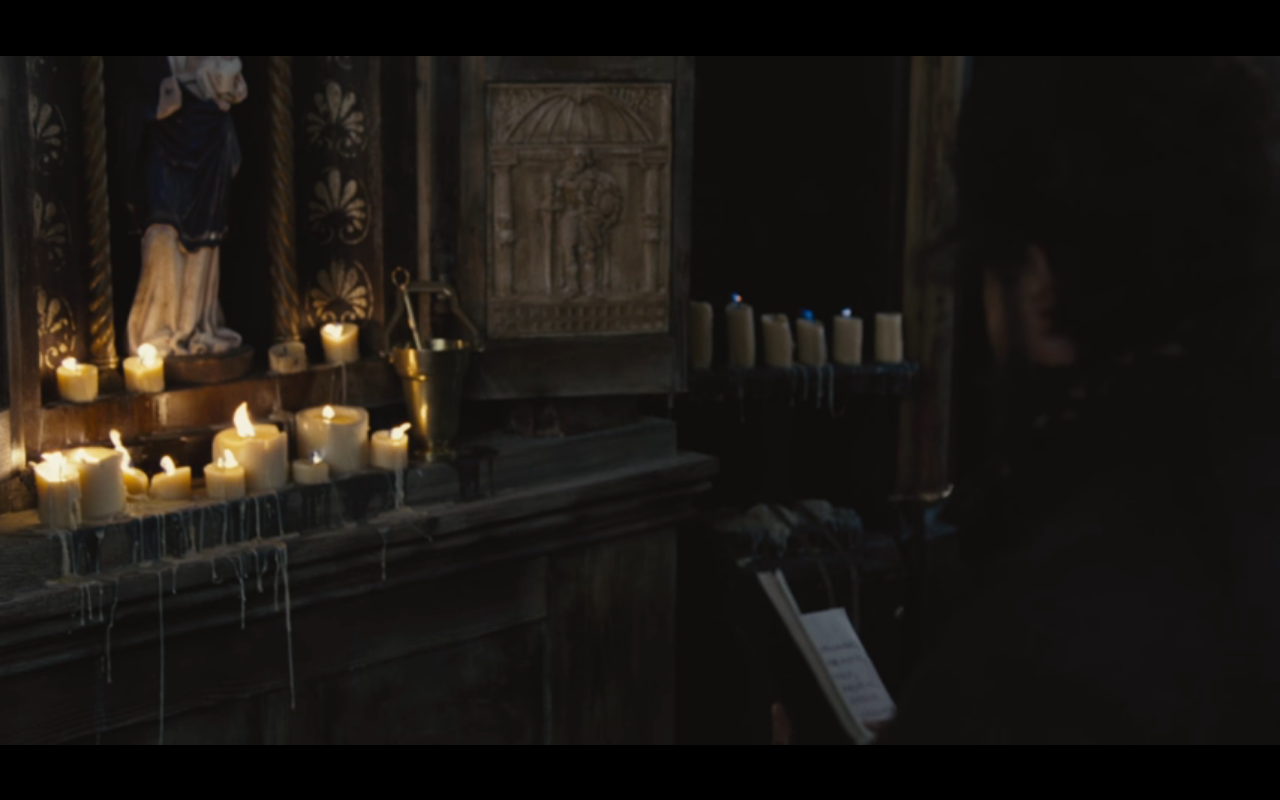
The Film: The Armada is the largest fleet ever seen, it is so large it cannot be completed in time, with the shipbuilders claiming only a miracle can see it done. Despite this, it is apparently built in time to react to the execution of Mary, Queen of Scots. It sails under the flag of Christ crucified and has shrines built into the deck so that the crew can pray (complete with candles) while about their duties.
In England, it is assumed that the Armada will be successful and the resulting invasion will see Elizabeth killed and Spain take the throne. Against the advice of Walsingham, Elizabeth goes to Tilbury to rally what troops they have gathered and delivers a speech to rouse them. She sits on her horse in full armour prepared to fight the Spanish alongside them. Sir Walter Raleigh takes his ship and joins forces with Drake to combat the Armada at sea before it can reach England.
The English fleet is vastly outnumbered and the Spanish immediately begin picking off what ships they do have, but their advantage is lost when the wind turns against them. Dropping anchor so as not to break their formation, the Spanish fall to their knees in prayer while Raleigh sets fire to his ship and steers it towards the fleet.
Elizabeth beholds her victory from the cliff edge, looking over the fired Spanish ships as the English return to port, having recovered Raleigh from the sea.
In History: The Armada was indeed a large fleet, but it had not been created under conditions that deforested Spain or left the shipbuilders praying for a miracle. The fleet was made up of a few new ships, with the bulk made up of the existing Spanish fleet and privately owned vessels that were requisitioned by the government to form part of the Spanish navy. Much of the Armada was not built to attack, but to convey the troops and the battleships to England. The English fleet outnumbered the Spanish but did not match their firepower.
The Spanish did not gain an early advantage and in fact did not take advantage of some opportunities presented to them, acting under Philip’s orders. Raleigh assisted in the defence of England on land and did not take to sea, though the Lord High Admiral, Charles Howard used Ark Royal, a ship that once belonged to Raleigh, as his flagship. Charles Howard and Francis Drake were responsible for the English action and set fireships among the Spanish to break their formation. By the time Elizabeth gave her address at Tilbury, the fireships had already done their damage and the English fleet had already engaged the scattered Spanish in battle. At Tilbury, the Earl of Leicester was maintaining a standing force in case the Spanish managed to get near the Thames and attack London, but the attack never came as the fleet continued to suffer from the weather. The Spanish ships that survived couldn’t protect themselves having already cut their anchors to avoid the fireships and less than seventy made it back to Spain.
Francis Walsingham
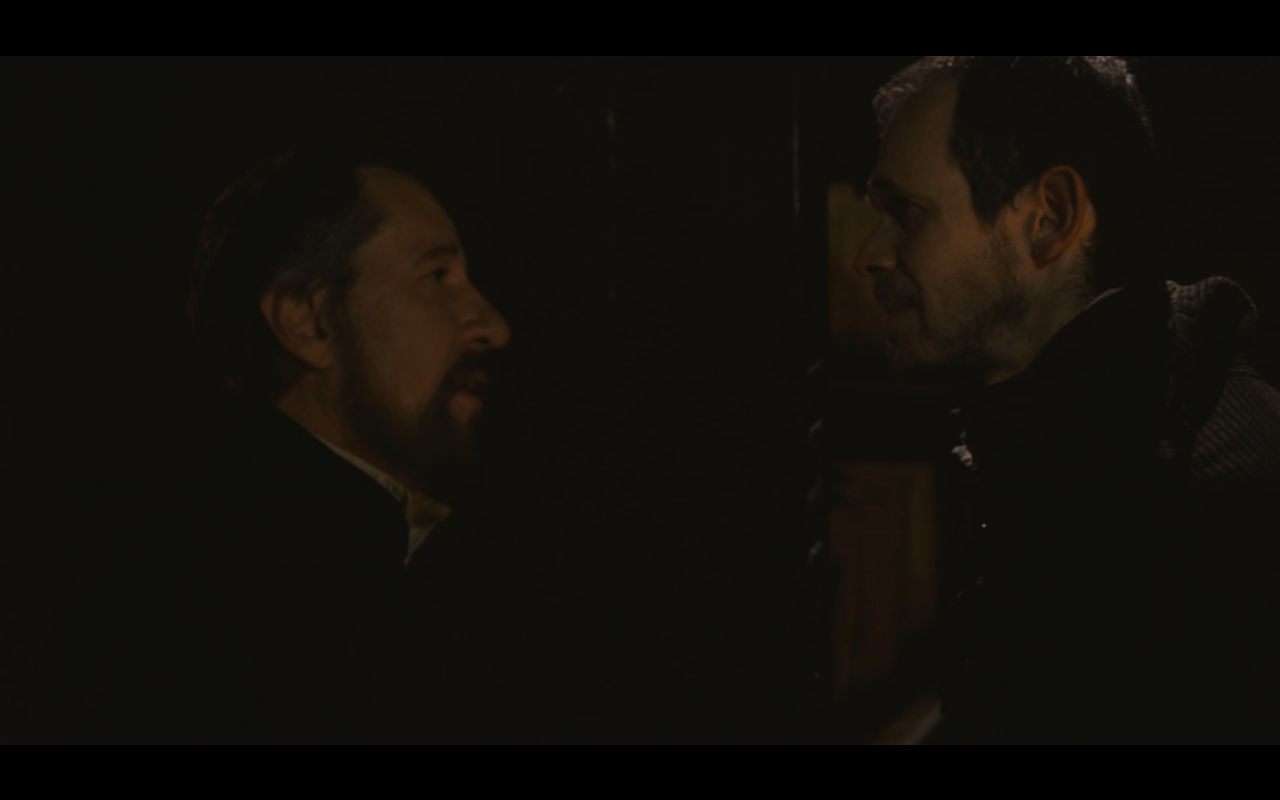
The Film: Walsingham is Elizabeth’s chief advisor and spymaster. However, he is old and suffers from the occasional illness, exacerbated by the weight of his responsibilities and serving an obstinate queen. His efforts to secure the throne include spying on Mary Queen of Scots and encouraging Elizabeth to marry. Elizabeth is often antagonistic towards him, overworking him while also using the threat of retirement when he oversteps his mark. He tortures and executes papists which alerts him to the Babington Plot. Despite this, the plot continues resulting in an assassination attempt on the Queen. Walsingham’s brother is implicated in the plot, something Walsingham reveals to his brother when he tries to kill him. He arranges for his brother to be smuggled to France in secret so that he will not die for his crimes, but Elizabeth is seemingly aware of this. After the Armada has been defeated Walsingham succumbs to his old age and illnesses and dies after Elizabeth gives him her thanks and blessing in the presence of his wife and their young children.
In History: Although Walsingham was a pivotal figure during Elizabeth’s reign as her spymaster and he was integral to the implication of Mary, Queen of Scots, much of his role in the film is largely an amalgam of his role and those of William Cecil and Robert Dudley who do not appear. At the time the film is set Walsingham was middle-aged, but suffered from occasional bouts of illness which required him to retire from court to recover, it’s possible that his illnesses were indeed exacerbated by his role at court. Elizabeth often butted heads with Walsingham as the latter refused to sugarcoat his advice and often told her things she did not want to hear, but ultimately she respected him for it. Along with Cecil, he determined that the threat posed to Elizabeth by Mary, Queen of Scots was great indeed and he allowed her to engage with Anthony Babington so that he might gather evidence against her. Ultimately, he was successful and Mary was executed, but he had no brother to be a part of it, though he had several sisters (none of which were embroiled in treason). The character of William Walsingham is entirely fabricated. Walsingham did die after the Spanish Armada at the age of fifty-eight. He died quietly at home, but he did not have a gathering of children present as he and his wife had only one surviving child – a daughter, Frances Walsingham, who by that point had married for the second time to the Earl of Essex.
Walter Raleigh
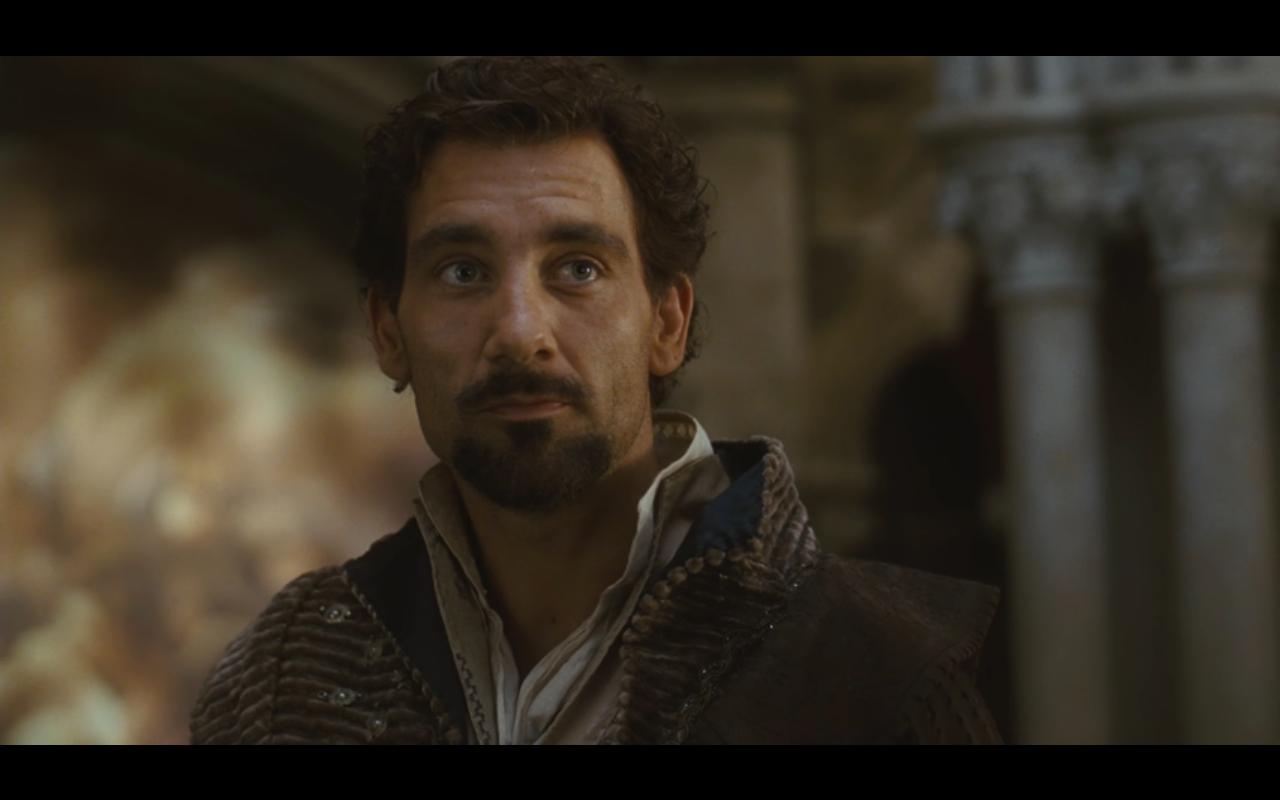
The Film: Unknown at court, Walter Raleigh has returned to England from the New World, where he has discovered and created the land of Virginia. He returns to gain the Queen’s patronage for the colony in the hopes that he can return to it and help it flourish, while also bringing her the fruits of his exploration; namely potatoes, tobacco and plundered Spanish gold.
As an explorer rather than a courtier, living on the fringes of court life, Elizabeth grows to like him attracted by his sincerity over the falseness of the court. She has to conduct much of their developing friendship through her lady-in-waiting, Bess Throckmorton, who has already caught Raleigh’s eye.
Elizabeth’s relationship with Raleigh becomes a point of gossip in foreign courts and the Spanish ambassadors in England openly criticise her for a pirate into her bed. By now Raleigh has tired of the court and wants to return to his colony at Virginia, but Elizabeth forces him to remain, making him Captain of her Personal Guard which causes tensions between the two. Raleigh smarts against her control of him and challenges her when given the opportunity. He embarks on an affair with Bess; unbeknownst to him when Elizabeth forces the pair to dance with each other she imagines herself in Bess’ place, replacing Robert Dudley in her memories with Raleigh. During the execution of Mary, Queen of Scots, Raleigh is the only one who can comfort her. The two are reconciled and admit how they have loved each other, even though by now Bess is pregnant by Raleigh. Despite Bess’ protestations that she needs nothing from Raleigh, he marries her which sees him imprisoned by Elizabeth for seducing a ward of the court. He is released to fight against the Armada and uses his own ship as a fire ship, piloting it himself until the last moment. After the victory Raleigh returns to Bess and their son, hoping to one day return to the New World, but content to remain with his family for the time being.
In History: Raleigh could be argued to be unknown at court in that he didn’t come from a particularly established family. His mother was a niece of Kat Ashley and so he was likely introduced at court through maternal connections, but it was his efforts on behalf of the Protestant Church in Ireland that brought him to the attention of Elizabeth I. In 1584 Elizabeth granted Raleigh a charter which allowed him to establish a settlement in the New World on behalf of England. Although Raleigh would later establish the colony at Roanoke (famous for its disappearance) he didn’t visit North America himself. Virginia would not be created until 1607, after Elizabeth’s death, by The Virginia Company which Raleigh had no involvement in. Ultimately, he does not create the colony the film suggests he does nor does he return to the New World to settle there, though he did make some journeys in search of the legendary ‘El Dorado’.
Far from being overwhelmed by favour, it wasn’t until the early 1590s that Elizabeth began granting him titles and gifts, but there was no question of the two of them having an affair. As was standard among Elizabeth’s admirers, Raleigh pretended that the Queen was the only woman in the world as far as he was concerned, even while he conducted a discreet affair with Bess Throckmorton. When Elizabeth found out about the affair, Raleigh was imprisoned in the Tower of London, though briefly released to fight against the Spanish in a naval skirmish unrelated to the Armada, and returned there after its completion. As for the Armada itself, Raleigh’s ship saw more action than he did, as Lord Howard, Admiral of the Fleet took Raleigh’s Ark Royal for his flagship, while Raleigh saw to the defences in Devon. Raleigh played a larger part in the later Spanish invasion attempt of 1597 where once again the Spanish were dispersed largely by bad weather more than the skill of the English.
Bess Throckmorton
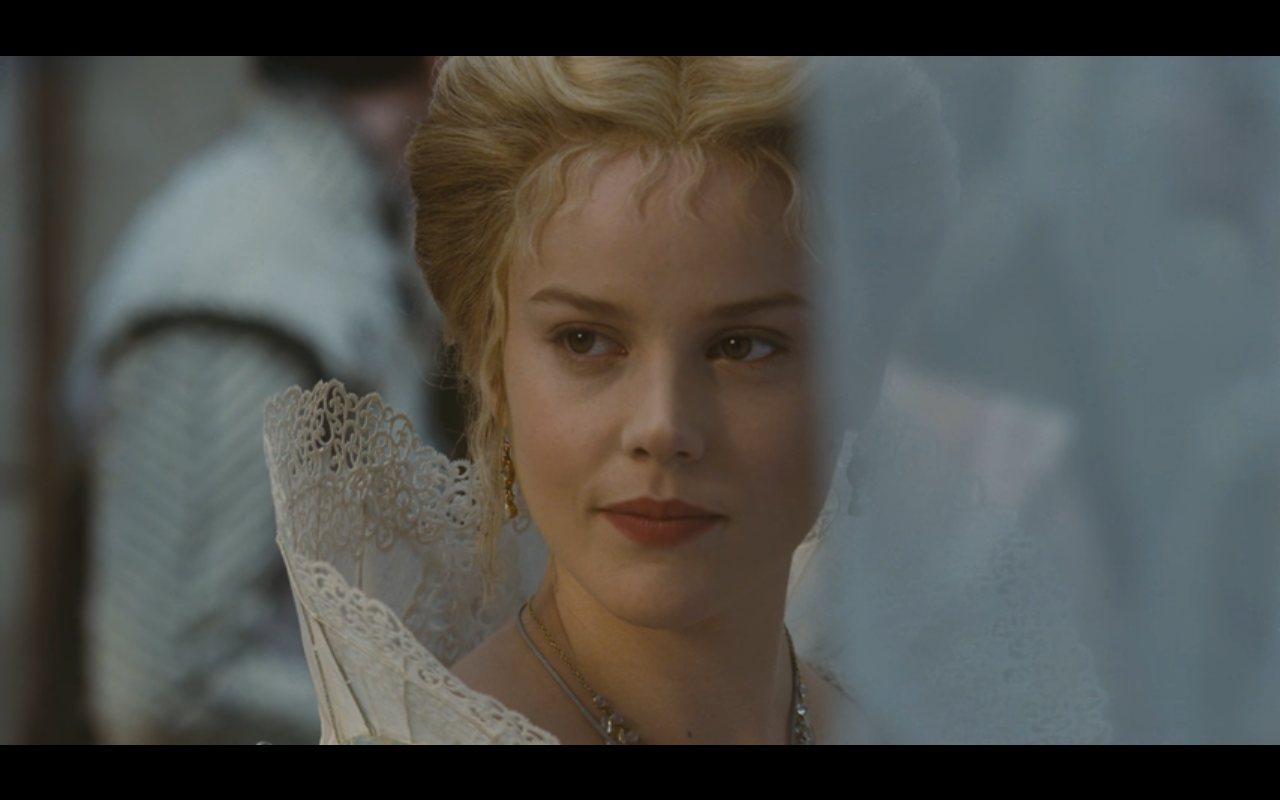
The Film: Bess is easily the favourite of all the Queen’s ladies and the two are intimately close as Elizabeth views her as much as a friend as a servant, with Bess taking on responsibility for much of the Queen’s personal attendance and running personal errands that the Queen wants to keep from her councillors. Initially, Elizabeth learns more about Walter Raleigh it is through Bess who she dispatches to meet him on her behalf. Referring to Bess as ‘her little adventurer’ Elizabeth has a sense of living vicariously through her. When Bess’ Throckmorton cousins appeal to her to be restored to the Queen’s favour, she refuses as they are papists. Raleigh comes upon her distraught at their subsequent execution and they embark on an affair. When she falls pregnant, Bess tells Raleigh that she expects nothing from him, aware that his life is in his new colony not in England with her. Despite this, they are soon secretly married, but Elizabeth finds out. The Queen slaps and berates Bess before imprisoning her for marrying without permission. After the events of the Armada, Bess is released, reunited with Raleigh and reconciled to the Queen who gives her blessing to their baby.
In History: Bess entered the Queen’s service in 1584, at age nineteen. As she had been at court from a young age she picked up her duties quickly and her diligence secured her as one of Elizabeth’s favourites. She fell in however with a particularly wild crowd at court that surrounded the Earl of Essex, another of the Queen’s favourites. Raleigh was also a part of this group and as Captain of the Gentlemen Pensioners had access to the Queen and her ladies. Raleigh and Bess embarked upon an affair and she fell pregnant by him, begging him to marry her when she discovered it. Raleigh did so, but the event was kept secret and after the fact the two resumed their lives as if nothing had happened, facing down the rumours. Bess hid her pregnancy until she was able to secure a leave of absence at eight months. By now the rumours were reaching fever pitch and aware that it would look damning to visit his wife, Raleigh remained at his duties while Bess delivered their son alone. She left the baby with a wet nurse and returned to court within weeks, hiding any evidence of the baby. Elizabeth discovered the affair and was incensed for a number of reasons; there was her natural aversion to her ladies marrying, there was the fact that Bess had married without permission and in doing so had violated her oath of service, that and Raleigh was one of her favourites and had betrayed their affection. This betrayal was compounded by the birth of a son and further compounded by the impunity with which Bess returned to her duties after the birth. Raleigh and Bess were imprisoned and though they were released, Bess was never reconciled with the Queen, forced to live the rest of her life beyond the court. Their son Damerei died of the plague in infancy and Elizabeth did not give him her blessing as a newborn.
Elizabeth’s suitors
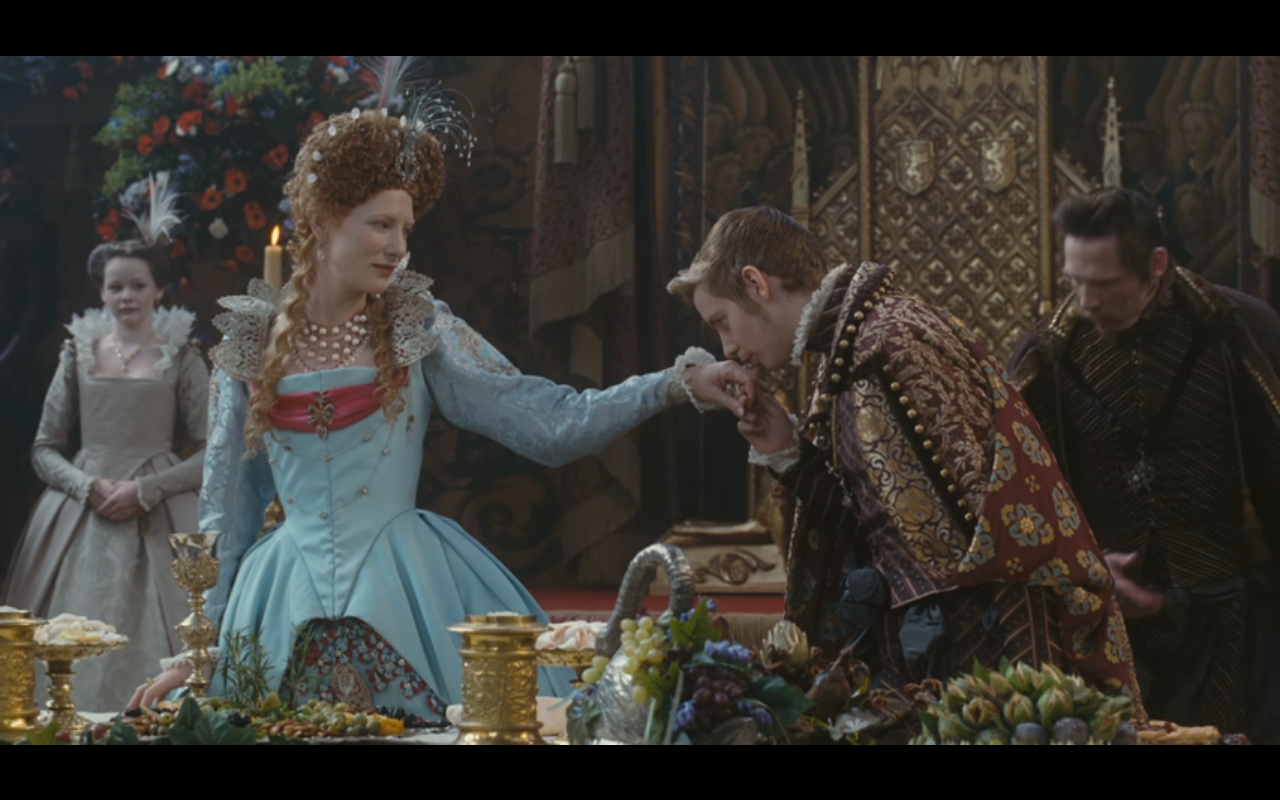
The Film: Walsingham continues to impress upon the Queen that marriage is the only way to secure the English throne and to prevent the many rumours that she is barren. While Elizabeth longs for “an honest man” from across the seas where Raleigh has been travelling, the main contenders presented for her consideration are King Erik of Sweden, Ivan the Terrible and the Archduke Charles of Austria. Elizabeth allows the Archduke Charles to visit, but he is extremely young and awkward, speaking in stunted English. Elizabeth surprises him by speaking in German and they reach a clear understanding that he doesn’t want to be there, nor married to her and she allows him to retire.
In History: At the time the film is set the last serious suit of Elizabeth’s reign had fallen through and the man concerned, Duke Francis of Anjou had already died. After Anjou Elizabeth and her councillors didn’t seriously entertain any more proposals of marriage. King Erik of Sweden had proposed marriage to Elizabeth early in her reign before he was king, but was rejected. By the time the film is set Erik had gone insane, been removed from the throne and died after being poisoned so was unlikely to have been pursuing the Queen. Likewise, Ivan the Terrible was already dead by the time of the film. The Archduke Charles was at least alive in 1585 but had been married for six years and had eleven of his fifteen children, so not in the market for a wife.
John Dee
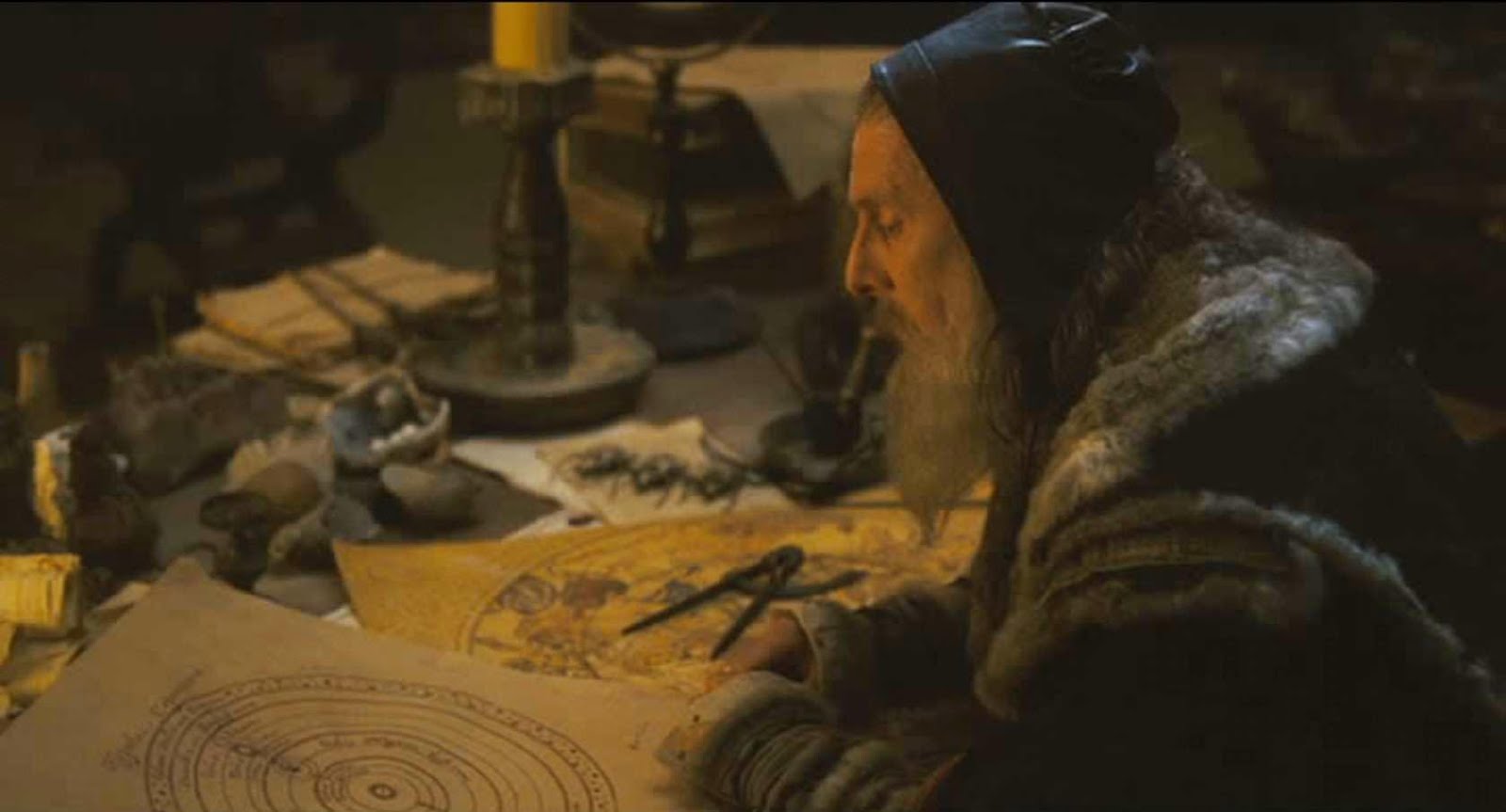
The Film: Doctor John Dee is one of Elizabeth’s advisors who she consults on matters of the future. As he is a practitioner of astrology and other such arts he is criticised by Walsingham who does not share his view that astrology is a science. Elizabeth turns to him for advice regarding first Raleigh and then the Armada, but Dee’s advice is vague. He does call her ‘my child’ and is able to read her body language suggesting a long and close relationship, likewise Elizabeth is warm towards him and trusts in his predictions.
In History: Doctor Dee, philosopher, astrologer and mathematician was an occasional advisor to Elizabeth I who cultivated relationships with her councillors. It was under advice from Dee that Elizabeth chose the date for her coronation but by the mid 1580s Dee and his associate, Edward Kelley, were travelling Europe. At the time of the Armada Dee was still abroad and wasn’t close enough to Elizabeth to have such a relationship that would see him as a principal advisor or that he would call her ‘my child’.
1585

The Film: The entirety of the film is set in 1585.
In History: None of the film’s events occurred in 1585, here’s a brief timeline of the major events and when they took place.
- 1584 – Elizabeth gives Raleigh permission to explore the New World
- 1585 – Raleigh is knighted
- 1586 – The Babington Plot
- 1587 – Execution of Mary, Queen of Scots and Raleigh’s second expedition where he settles the colony at Roanoke
- 1588 – The Spanish Armada
- 1590 – Walsingham dies
- 1591 – Raleigh and Bess Throckmorton marry in secret
- 1592 – Damerei Raleigh is born to Bess in secret, Elizabeth discovers the marriage and imprisons Bess and Raleigh. Raleigh is released in June, Damerei dies in October and Bess is released in December.
Conspicuous by their absence…
Robert Dudley: Dudley is absent in this film having taken part in a treasonous plot against Elizabeth in the previous film. Historically however, he was still very much at court and the established favourite of the Queen. He served as Lieutenant General of Elizabeth’s army at Tilbury which she referenced in her Speech to the Troops at Tilbury. His death after the victory of the Spanish Armada devastated Elizabeth and she locked herself away until William Cecil had her doors broken down so that she may begin the celebration festivities.
William Cecil – Also absent after Elizabeth dismisses his advice in the first film as ultimately useless and sends him away. Cecil remained high in both politics and Elizabeth’s favour until his death in 1598.
Robert Devereux – Although not cemented as a favourite of the Queen by 1585, the Earl of Essex was still a prominent courtier. Around him, he gathered a circle of younger courtiers and ladies in waiting who were known for keeping late hours and their excessive pleasures. Many of his circle, including Essex himself, incurred the Queen’s wrath by engaging in a secret marriage and/or a hidden pregnancy, Bess Throckmorton and Walter Raleigh among them.
In conclusion, save yourself the trouble and watch Elizabeth I (2005) with Helen Mirren and Jeremy Irons or The Virgin Queen (2005) with Anne-Marie Duff and a young Tom Hardy.
If you’d like to join me for more fun and games in picking apart history, and other behind the scene tangents, you can support me via my Patreon.













